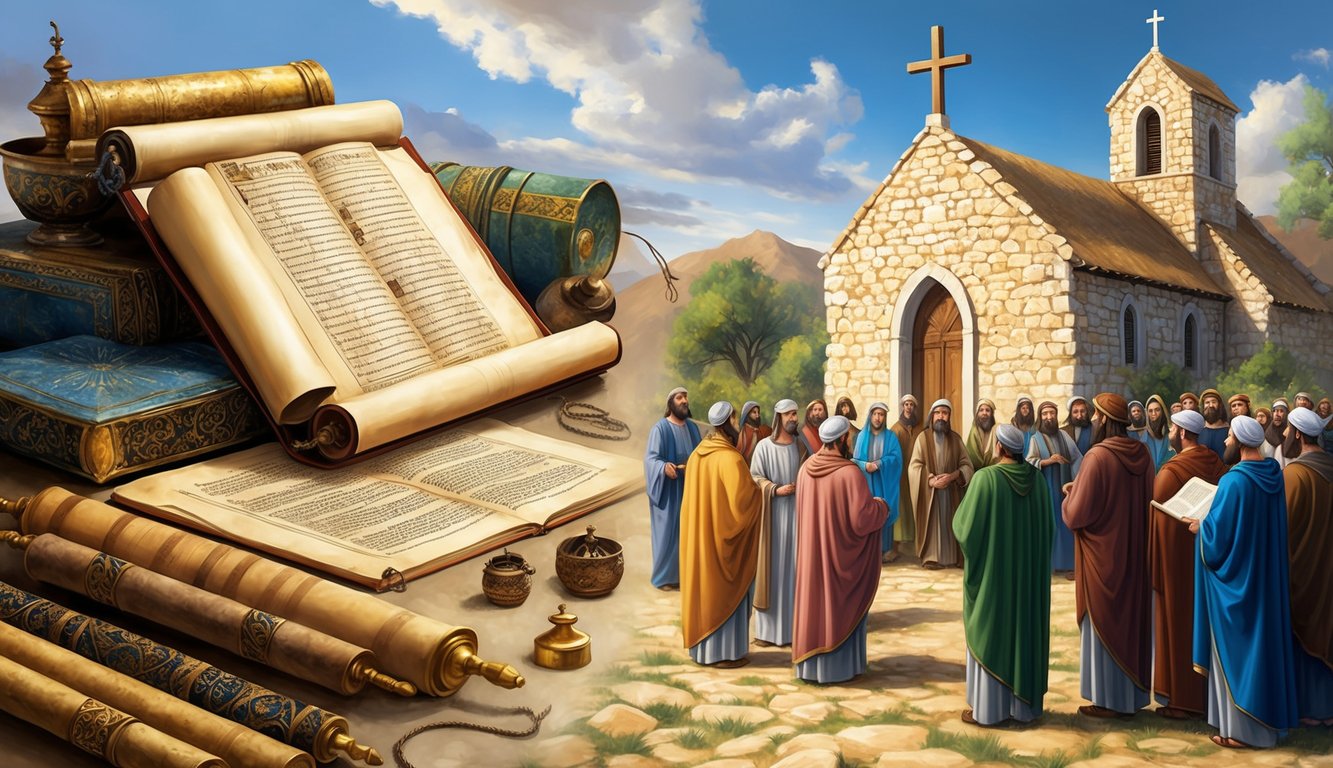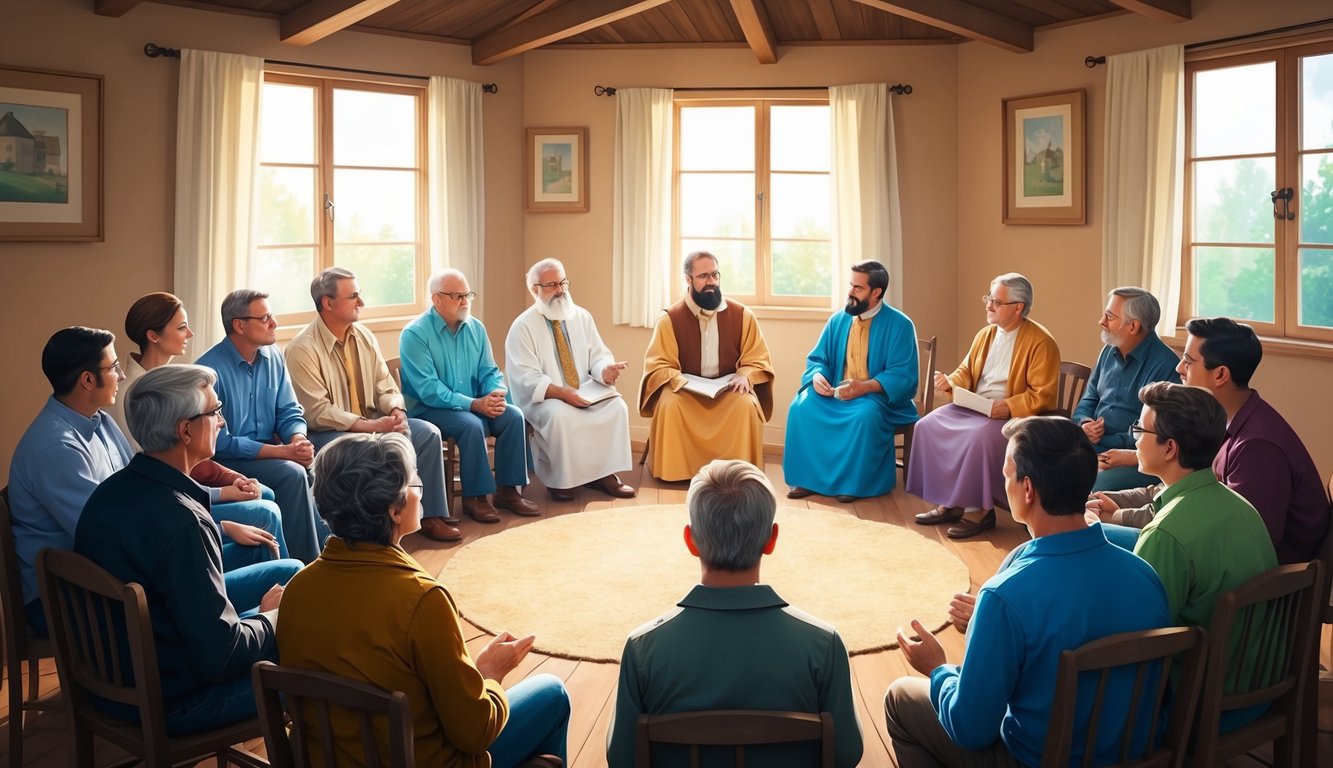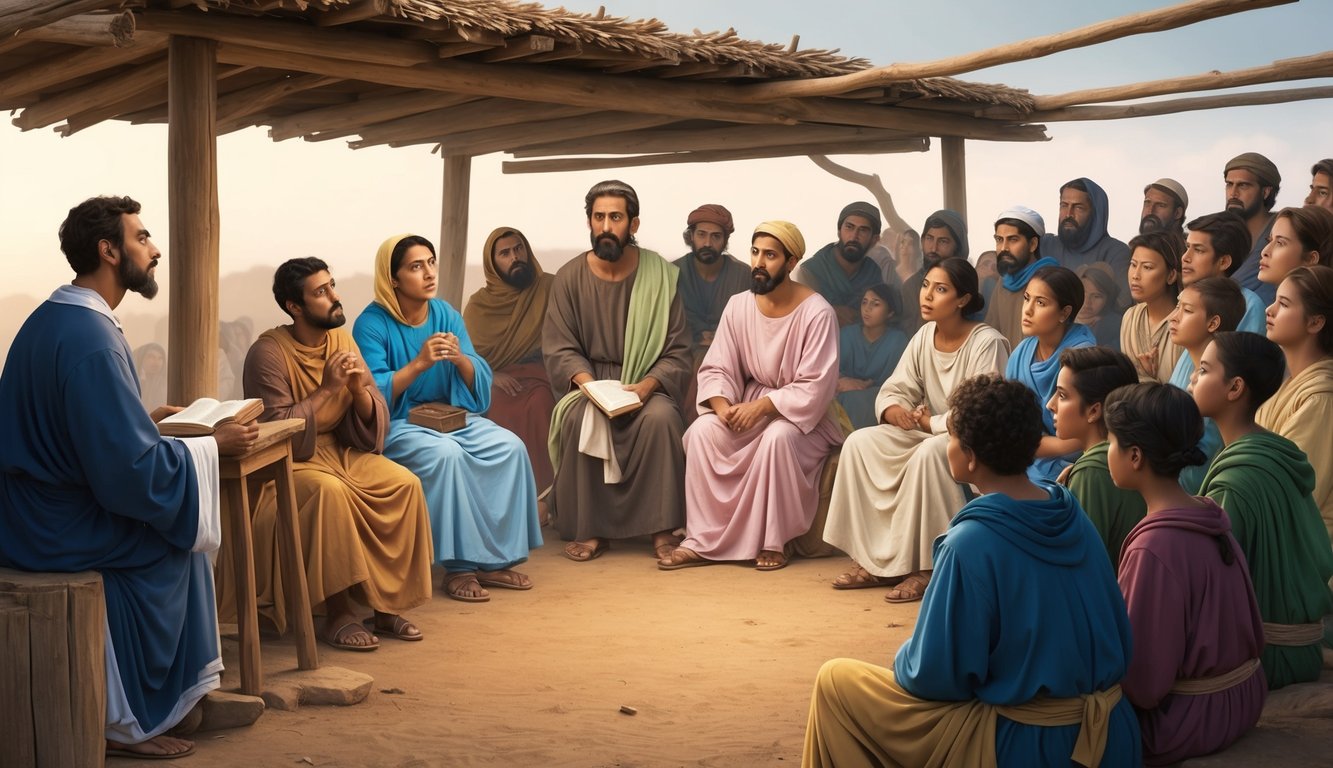Don’t Miss Out On This Unique Astrological Opportunity
Are you tired of spinning your wheels and getting nowhere? Simply put, you’re out of sync: you’re out of alignment with your astral configuration.
But: there’s a kind of map that can help you reclaim your alignment. Think of it as your own personal blueprint to success and happiness: a blueprint that will help you live your most amazing life.
Get started here.
Early Christianity is a rich and fascinating topic that reveals a lot about the beginnings of your faith.
Many people might think they know the basic story, but there are surprising details that can change your perspective on its early years. Exploring these eight eye-opening facts can deepen your understanding of how this movement grew and thrived despite many challenges.

From its roots in Judaism to its expansion throughout the Roman Empire, early Christianity set the stage for the beliefs and practices that many hold today.
You may find it inspiring to learn how early followers of Christ faced persecution while still spreading their message far and wide.
Each fact you discover offers a glimpse into the determination and faith of those who laid the groundwork for your beliefs.
The Didache’s Community Guidelines
The Didache, sometimes called the “Teaching of the Twelve,” offers practical instructions for early Christian communities.
Its guidelines cover various aspects of life, leading believers in their faith.
One notable feature is the “Two Ways” teaching.
It contrasts the paths of life and death, helping you to understand good and evil choices.
This sets a foundation for moral living.
The Didache also describes how to conduct church services and rituals.
You’ll find details on baptism, fasting, and the Eucharist, showing the importance of community worship.
Additionally, it emphasizes ethical behavior.
Advice is given on respecting authority, treating others kindly, and living simply.
These teachings encourage a supportive community.
In essence, the Didache serves as a guide for living a faithful life.
It helps you connect personal conduct with community values, fostering a sense of belonging among believers.
Paul’s letters predating the Gospels
Paul’s letters are some of the earliest writings in the New Testament.
Many scholars believe they were written before the Gospels, which include Matthew, Mark, Luke, and John.
These letters provide insights into the early Christian faith.
You can see Paul’s thoughts on Jesus and teachings that shaped the church.
His letters, such as Galatians and 1 Thessalonians, address different issues faced by early Christians.
Paul traveled extensively and wrote back to the communities he established.
His letters helped those communities understand their faith better.
They were often written to address specific problems or to encourage believers.
Since these writings came first, they give us a window into the Christianity that existed before the Gospels were fully formed.
You can think of them as foundational texts that laid groundwork for the teachings about Jesus found in the later Gospels.
This early correspondence shows how quickly the teachings of Christ spread.
It also highlights the role of Paul in shaping early Christian beliefs.
By reading his letters, you can connect with the heart of early Christianity.
3) Women leaders in early churches
In the early Christian communities, women played important leadership roles.
They were more than just supporters; they actively led and served in various capacities.
For instance, women are noted as being the last at the cross and the first at the empty tomb.
This shows their crucial role in the early church’s core events.
The Apostle Paul mentioned women like Phoebe, who served as a deacon, and Junia, noted as an apostle.
These examples highlight that women held positions of influence.
Additionally, some churches had groups of widows who took on formal ministry roles.
This allowed them to contribute significantly to their communities.
Women also hosted house churches, creating spaces for worship and fellowship.
Their leadership helped shape the early church in many ways.
4) Constantine’s conversion impact
Constantine’s conversion to Christianity in 312 CE significantly changed the course of the religion.
He was the first Roman emperor to embrace Christianity.
This act helped legitimize the faith within the vast Roman Empire.
After his conversion, Constantine began promoting Christianity actively.
He issued the Edict of Milan in 313 CE, which granted religious tolerance to Christians.
This was a big shift from the earlier persecution they faced.
His support led to the construction of churches across the empire.
Constantine’s reign allowed Christianity to grow and gain followers more freely.
This period laid the groundwork for Christianity to become the dominant religion in the empire.
You can see how his vision and choices influenced many people.
It encouraged others to explore faith and brought Christianity to new areas.
Overall, his impact on the faith was monumental and lasting.
His dedication also inspired countless individuals to stay true to their beliefs despite challenges.
Even today, you can find celebrities who kept their faith and openly share their spiritual journeys, further spreading the message.
His legacy remains a powerful testament to the influence one person can have on the growth and perseverance of faith.
5) Use of House Churches Early On

In the early days of Christianity, believers often gathered in homes for worship and fellowship.
This practice was practical since many Christians faced persecution and needed safe spaces to meet.
House churches allowed communities to grow in intimacy and trust.
These gatherings helped you develop strong relationships with fellow believers.
You could share meals, study Scripture, and pray together in a comfortable setting.
The tradition of meeting in homes was rooted in Jewish customs, where family and community often worshipped together.
This connection to Jewish practices influenced how the early Church formed.
Even after the faith began spreading widely, house churches remained important.
They provided a sense of belonging and support, especially in areas where larger church buildings were not available.
The experience of worship in small settings often felt more personal and engaging.
As you participated in these gatherings, you became part of a close-knit family of faith.
6) Sunday as the new holy day

In early Christianity, Sunday became a special day for worship.
After Jesus’ resurrection, Christians wanted to remember this important event.
They chose Sunday, the first day of the week, as a day of joy and celebration.
Constantine played a key role in making Sunday a holy day in 321 CE.
He declared it a day of rest to honor both the sun god and the Christian faith.
This act helped solidify Sunday as a day to come together to worship.
Church gatherings often took place on Sunday mornings.
These meetings included prayers, hymns, and reading from Scripture.
The emphasis was on community and sharing faith.
Many early Christians continued to observe the Sabbath on Saturday but also celebrated Sunday.
They saw it as a time of new beginnings, reflecting the resurrection of Christ.
This blending of traditions helped shape Christian worship practices we see today.
As you consider the significance of Sunday, think about its roots and the joy it represents in your faith.
It’s a time to connect with God and fellow believers.
7) The symbolism of the fish

The fish symbol, known as Ichthys, holds great meaning in early Christianity.
It represents Jesus Christ and is a reminder of his role as a savior.
This symbol can be traced back to the time of Christ.
Early Christians used it as a secret sign to identify themselves, especially during times of persecution.
In Greek, the word for fish is “ichthys,” and it stands for “Jesus Christ, God’s Son, Savior.” This acronym helped believers express their faith discreetly.
The fish was also a common food in the ancient world, symbolizing sustenance and life.
It links to stories of Jesus feeding the multitudes and his miracles.
Jesus used the fish to explain important teachings, like the Sign of Jonah, which points to his resurrection.
This event is central to the Christian faith and reinforces the fish’s significance.
By using the fish as a symbol, early Christians connected their faith with everyday life.
It portrayed their hope, identity, and community.
The ichthys remains a powerful emblem of faith today.
8) Canonization Debate at Nicaea

The First Council of Nicaea took place in 325 CE.
This event was called by Emperor Constantine I and gathered many Christian bishops to discuss important issues facing the church.
One key topic was Arianism, which challenged the nature of Christ.
This debate shaped early Christian beliefs but did not settle the question of the Biblical canon.
While people often think the Council of Nicaea established the Bible’s canon, this isn’t true.
The canon was debated for several centuries before and after Nicaea.
Many early Christian texts were already in use, and different groups had varying opinions on which writings to include.
The council did create the Nicene Creed, affirming core Christian beliefs.
However, the formation of a complete and recognized Biblical canon happened gradually.
It involved many church leaders and discussions over time.
Origins of Early Christianity

Early Christianity began in a unique setting where various cultural and religious influences shaped its development.
The movement is deeply connected to Jewish traditions and the teachings of Jesus.
As you read, you will discover how these elements combined and led to the spread of Christianity.
Historical Context and Influences
In the 1st century CE, early Christianity emerged from a small Jewish sect.
This time was marked by the Roman Empire’s vast influence, which connected different cultures and ideas.
Key Influences:
- Jewish Traditions: Early Christians drew from Jewish beliefs, including monotheism.
- Greco-Roman Culture: Elements of Greco-Roman religion and philosophy also shaped early Christian thought.
Spread Through the Roman Empire
Christianity quickly expanded beyond its Jewish roots.
The Roman Empire’s extensive road system and common language helped this spread.
Factors in the Spread:
- Travel Networks: Missionaries could preach and convert others on safe travel routes.
- Diaspora Communities: Jewish communities in various cities played a vital role in sharing Christian beliefs.
By connecting with existing populations, early Christians could easily share their message.
Over time, these efforts led to significant growth in followers across the empire, changing the religious landscape forever.
Key Doctrines and Beliefs

Early Christianity has several important doctrines and beliefs that shaped its development.
Understanding these can help you see how Christianity grew from its roots in Judaism and how it influenced the wider world.
The Role of the Apostle Paul
The Apostle Paul was crucial in spreading Christian teachings.
Originally a persecutor of Christians, he had a powerful conversion experience.
Afterward, he dedicated his life to sharing the message of Jesus.
Paul traveled extensively, establishing churches and writing letters.
His letters, or epistles, clarified key beliefs, like salvation through faith in Jesus.
He argued that anyone, regardless of background, could follow Christ.
His efforts helped Christianity branch out from Jewish communities to the Greco-Roman world.
This opened the faith to many new followers.
Paul’s teachings focused on grace, love, and community, making Christianity more accessible.
Development of Christian Texts
The early Christian community relied on various texts to express their beliefs.
The New Testament emerged from writings by apostles and early church leaders.
These texts include the Gospels, letters, and other writings that explain the life and teachings of Jesus.
The process of deciding which texts to include was essential.
Different communities used various texts, creating diversity in early Christianity.
However, by the 4th century, the church recognized certain writings as authoritative.
These texts shaped beliefs about Jesus’ life, death, and resurrection.
They also provided guidance on morality, worship, and church organization.
This foundation influenced how Christianity developed as a faith and community.
Frequently Asked Questions

This section covers common questions about early Christianity, highlighting the practices, history, and unique traits of the early church.
You will learn about the key moments and influential figures that shaped its development.
What practices defined the early Christian community?
The early Christian community had unique practices that set them apart.
They met in house churches, shared meals, and held prayer services.
The Didache, an ancient text, provided guidelines for community life, including teachings on baptism and prayer.
Can you outline a brief history of Christianity from its inception?
Christianity began in the 1st century CE as a small sect of Judaism.
It spread rapidly through the Roman Empire, especially due to the efforts of Paul.
His letters, written before the Gospels, helped establish important beliefs and practices within the faith.
Who established the first church according to biblical records?
According to the Bible, the first church was established by the apostles after Jesus’ resurrection.
Peter is often recognized as a key leader in this early community, guiding followers in faith.
His role was vital in shaping the direction of the early church.
What are some unique characteristics that distinguished the early church from other religious groups?
The early church emphasized community and inclusivity.
They welcomed diverse groups, including women as leaders, which was unusual for the time.
Their focus on love, service, and sharing resources set them apart from other religious groups in the Roman world.
How did early Christianity evolve during its formative years?
Early Christianity evolved through interactions with various cultures and philosophies.
The integration of Greco-Roman ideas shaped its beliefs and practices.
This evolution helped Christianity appeal to a broader audience and facilitated its growth across different regions.
What key events impacted the development and spread of early Christianity?
Several significant events shaped early Christianity.
Paul’s mission to spread the gospel beyond Jewish communities was crucial.
Constantine’s conversion and support for Christianity in the 4th century also played a major role, leading to its acceptance in the Roman Empire.



